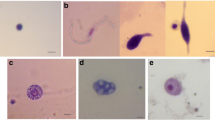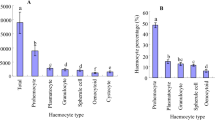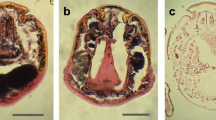Abstract
Haemocytes of the hard tick Ixodes ricinus were characterized on the basis of their ultrastructure, their ability to ingest foreign material, and to produce or store molecules of the immune defence. Distinction was made between types of haemocytes according to the absence or presence of granular inclusions, shape and size of the lysosomal compartment or the rough endoplasmic reticulum, and ultrastructural and functional similarity to the corresponding haemocytes of insects. Three types of haemocytes were found in adult ticks: plasmatocytes and type-I and type-II granular haemocytes, respectively. The precipitated reaction product of acid phosphatase activity revealed the shape of the lysosomal compartment. The additional injection of particulate materials into the haemocoel further revealed the endocytic activity of the haemocytes. The lysozyme-like immunoreactivity of the haemocytes suggests bactericidal potential. Detection of immunoreactivity in haemocytes to a 25 kDa antigenic protein involved in cuticle formation further suggests their involvement in wound healing and encapsulation.
Similar content being viewed by others
References
Altman LG, Schneider BG, Papermaster DS (1984) Rapid embedding of tissues in Lowicryl K4M for immunoelectron microscopy. J Histochem Cytochem 32:1217–1223
Amosova LI (1983) Tissues of the internal environment. In: Balashov YS (ed) An atlas of ixodid tick ultrastructure. Entomological Society of America, pp 147–174
Armstrong PB (1985) Adhesion and motility of the blood cells of Limulus. In: Cohen WD (ed) Blood cells of marine invertebrates. Liss, New York, pp 77–124
Ashhurst DE (1979) Hemocytes and connective tissue: a critical assessment. In: Gupta AP (ed) Insect hemocytes. Cambridge University Press, Cambridge, pp 319–330
Baerwald RJ (1979) Light, transmission, and scanning electron microscopic techniques for insect hemocytes. In: Gupta AP (ed) Insect hemocytes. Cambridge University Press, Cambridge, pp 563–577
Balashov YS (1972) Bloodsucking ticks (Ixodoidea) — Vectors of diseases of man and animals. Misc Publ Entomol Soc Am 8:161–376
Ball EE, Couet HG de, Horn PL, Quinn JMA (1987) Haemocytes secrete basement membrane components in embryonic locusts. Development 99:255–259
Bauchau AG (1981) Crustaceans. In: Ratcliffe NA, Rowley AF (eds) Invertebrate blood cells. Academic Press, London, pp 385–420
Binnington KC, Obenchain FD (1982) Structure and function of the circulatory, nervous, and neuroendocrine systems of ticks. In: Obenchain FD, Galun RL (eds) Physiology of ticks. Pergamon Press, Oxford, pp 351–398
Boman HG, Faye I, Gudmundsson GH, Lee JY, Lidholm DA (1991) Cell-free immunity in Cecropia — a model system for antibacterial proteins. Eur J Biochem 201:23–31
Brehélin M, Zachary D (1986) Insect haemocytes: a new classification to rule out the controversy. In: Brehélin M (ed) Immunity in invertebrates. Springer, Heidelberg, pp 36–48
Brinton LP, Burgdorfer W (1971) Fine structure of normal hemocytes in Dermacentor andersoni Stiles (Acari: Ixodidae). J Parasitol 57:1110–1127
Chain BM, Anderson RS (1983) Observations on the cytochemistry of the hemocytes of an insect, Galleria mellonella. J Histochem Cytochem 31:601–607
Crossley AC (1979) Biochemical and ultrastructural aspects of synthesis, storage, and secretion in hemocytes. In: Gupta AP (ed) Insect hemocytes. Cambridge University Press, Cambridge, pp 423–473
Eggenberger LR, Lamoreaux WJ, Coons LB (1990) Hemocytic encapsulation of implants in the tick Dermacentor variabilis. Exp Appl Acarol 9:279–287
El Shoura SM (1986) Fine structure of the hemocytes and nephrocytes of Argas (Persicargas) arboreus (Ixodoidea: Argasidae). J Morphol 189:17–24
El Shoura SM (1989) Ultrastructure of the larval haemocytes and nephrocytes in the tick Ornithodoros (Pavlovskyella) erraticus (Ixodoidea: Argasidae). Acarol 15:35–40
Götz P, Boman HG (1985) Insect immunity. In: Kerkut GA, Gilbert LJ (eds) Comprehensive insect physiology, biochemistry, and pharmacology, vol 11. Pergamon Press, Oxford, pp 453–485
Grubhoffer L, Vereš J, Dusbábek F (1991) Lectins as the molecular factors of recognition and defence reaction of ticks. In: Dusbábek F, Bukva V (eds) Modern Acarology, vol 2. Academia, Prague and SPB Academic Publishing bv, The Hague, pp 381–388
Haug T, Rutti B, Brossard M (1989) Charakterisierung eines “protektiven” 25 kDa-Antigens der Schildzecke Ixodes ricinus: Immunologische Merkmale und immunoelektronenmikroskopische Lokalisierung. Verh Dtsch Zool Ges 82:241–242
Hose JE, Martin GG, Gerard AS (1990) A decapod hemocyte classification scheme integrating morphology, cytochemistry, and function. Biol Bull 178:33–45
Iwanaga S, Miyata T, Tokunaga F, Muta T (1992) Molecular mechanism of hemolymph clotting system in Limulus. Thromb Res 68:1–32
Jakobsen PP, Suhr-Jessen P (1990) The horseshoe crab Tachypleus tridentatus has 2 kinds of hemocytes—granulocytes and plasmatocytes. Biol Bull 178:55–64
Jones JC (1979) Pathways and pitfalls in the classification and study of insect hemocytes. In: Gupta AP (ed) Insect hemocytes. Cambridge University Press, Cambridge, pp 279–300
Kobayashi H, Kurata S, Natori S (1991) Purification of the 200 kDa hemocyte membrane protein of Sarcophaga peregrina and its specific interaction with fat body. Insect Biochem 21:517–522
Lackie AM (1988) Haemocyte behaviour. Adv Insect Physiol 21:85–178
Leonhard C, Söderhäll K, Ratcliffe NA (1985) Studies on prophenoloxidase and protease activity of Blaberus cranifer hemocytes. Insect Biochem 15:803–810
Levin J (1985) The role of amebocytes in the blood coagulation mechanism of the horseshoe crab Limulus polyphemus. In: Cohen WD (ed) Blood cells of marine invertebrates. Liss, New York, pp 146–163
Nardi JB, Miklasz SD (1989) Hemocytes contribute to both the formation and breakdown of basal lamina in developing wings of Manduca sexta. Tissue Cell 21:559–567
Ornberg RL (1985) Exocytosis in Limulus amebocytes. In: Cohen WD (ed) Blood cells of marine invertebrates. Liss, New York, pp 127–142
Pedersen KJ (1991) Invited review: structure and composition of basement membranes and other basal matrix systems in selected invertebrates. Acta Zool 72:181–201
Ratcliffe NA, Rowley AF, Fitzgerald SW, Rhodes CP (1985) Invertebrate immunity: Basic concepts and recent advances. Int Rev Cytol 97:183–350
Robinson JM, Karnovsky MJ (1983) Ultrastructural localisation of several phosphatases with cerium. J Histochem Cytochem 31:1197–1208
Roth J (1986) Post-embedding cytochemistry with gold-labelled regents: a review. J Microsc 143:125–137
Roth J, Taatjes DJ, Warhol MJ (1989) Prevention of non-specific interactions of gold-labelled reagents on tissue sections. Histochemistry 92:47–56
Rowley AF, Ratcliffe NA (1979) An ultrastructural and cytochemical study of the interaction between latex particles and the haemocytes of the wax moth Galleria mellonella in vitro. Cell Tissue Res 199:127–137
Rutti B, Brossard M (1989) Repetitive detection by immunoblotting of an integumental 25 kDa antigen in Ixodes ricinus and a corresponding 20 kDa antigen in Rhipicephalus appendiculatus with sera of pluriinfested mice and rabbits. Parasitol Res 75:325–329
Schwemmler W, Müller H (1986) Role of insect lysozymes in endocytobiosis and immunity of leafhoppers. In: Gupta AP (ed) Hemocytic and humoral immunity in arthropods. Wiley, New York, pp 449–462
Sherman RG (1981) Chelicerates. In: Ratcliffe NA, Rowley AF (eds) Invertebrate blood cells. Academic Press, London, pp 355–384
Sonenshine DE (1991) Biology of ticks, vol 1. Oxford University Press, New York
Suhr-Jessen P, Baek L, Jakobsen PP (1989) Microscopical, biochemical, and immunological studies of the immune defense system of the horseshoe crab, Limulus polyphemus. Biol Bull 176:290–300
Suzuki T, Funakoshi S (1992) Isolation of a fibronectin-like molecule from a marine bivalve, Pinctada fucata, and its secretion by amebocytes. Zool Sci 9:541–550
Suzuki T, Yoshinaka R, Mizuta S, Funakoshi S, Wada K (1991) Extracellular matrix formation by amebocytes during epithelial regeneration in the pearl oyster Pinctada fucata. Cell Tissue Res 266:75–82
Toh Y, Mizutani A, Tokunaga F, Muta I, Iwanaga S (1991) Morphology of the granular hemocytes of the Japanese horseshoe crab Tachypleus tridentatus and immunocytochemical localization of clotting factors and antimicrobial substances. Cell Tissue Res 266:137–147
Voigt WP (1988) Tick bites. In: Mehlhorn H (ed) Parasitology in focus. Springer, Berlin, pp 585–587
Warr GW, Cohen N (eds) (1991) Phylogenesis of immune functions. CRC Press, Boca Raton
Zachary D, Hoffmann D (1984) Lysozyme is stored in the granules of certain haemocyte types in Locusta. J Insect Physiol 30:405–411
Author information
Authors and Affiliations
Rights and permissions
About this article
Cite this article
Kuhn, K.H., Haug, T. Ultrastructural, cytochemical, and immunocytochemical characterization of haemocytes of the hard tick Ixodes ricinus (Acari; Chelicerata). Cell Tissue Res 277, 493–504 (1994). https://doi.org/10.1007/BF00300222
Received:
Accepted:
Issue Date:
DOI: https://doi.org/10.1007/BF00300222




